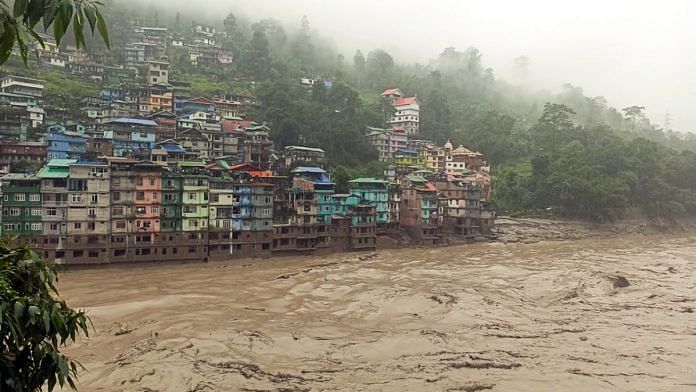Over the past six months, India has witnessed complex and alarming weather patterns. Early summers saw untimely rains and ended with severe heatwaves, followed by extreme rainfall and floods in July and a monsoon deficit. Finally, September experienced a late withdrawal of monsoon with extreme rainfall in half the country. Such erratic weather poses severe climatic risks to people, infrastructure, ecosystems and economies across the world. This International Day for Disaster Risk Reduction, it’s imperative that as one of the countries most affected by a warming world, India accelerates its actions on both climate and disaster resilience.
The world’s major economies—as part of the G20—now have a working group on disaster risk reduction (DRR) for the first time. It has five priority areas: early warning systems, climate resilient infrastructure, financing framework for disaster risk reduction, disaster response systems, and an ecosystem-based approach to risk reduction. But there are two evolving and urgent climate change trends that will need to be considered before India mobilises these actions.
One, according to research by the Council on Energy, Environment and Water (CEEW), more than 40 per cent of districts in India are reporting a swapping pattern in climatic disasters. Regions that were previously dry are seeing floods and vice-versa. Two, as per our analysis, there has been a near 24 per cent increase in the frequency of extreme hydro-met disasters such as floods and cyclones in the past two decades, which requires immediate attention. In 2023 alone, India has seen massive flooding across more than 50 per cent of districts. Addressing India’s subnational climate and disaster risks needs a holistic climate resilience approach that must integrate the actions on climate change and disaster risk reduction.
Also read: What turned Teesta into a killer? Here’s proof Sikkim flash floods are a man-made disaster
Infrastructure to investment
If India were to take the lead and realise these disaster reduction goals, it needs to prioritise the implementation of the following actions.
First, increase the coverage of early warning systems. Here, our cyclone preparedness shows the way. Over the past five decades, India has seen a fourfold increase in extreme cyclone events but 100 per cent of the cyclone-prone population has access to early warning systems. On the other hand, two-thirds of India’s population resides in flood-prone areas, but only one-third of this population has access to early warning systems. As flood events increase, the country will need to intensify its network of early warning systems, with more focus on enhancing the coverage in districts experiencing the compounding risks of multiple disasters.
The second is climate-proofing infrastructure. Gujarat and Rajasthan, for instance, have seen a combined fresh investment of Rs 6.35 lakh crore in FY 2022 from Indian and foreign companies, the highest in the country. However, over the past two decades, the Arabian Sea has seen a 52 per cent increase in tropical cyclones, which puts some of these mega investments at risk of direct impacts on existing and upcoming infrastructure. There is an urgent need to revisit the standards and regulations for climate-proofing infrastructure, businesses and industries in India, with a special focus on critical infrastructure such as energy, transport and health.
The next step is to invest in disaster risk reduction. None of the strategies will work without financing mechanisms. India needs Rs 85.6 lakh crore by 2030 to adapt to climate change. The private sector must capitalise on the opportunity to participate in financing mechanisms for reducing disaster risks by investing in adaptation strategies such as nature-based solutions and ecosystem-based approaches like protecting and restoring natural ecosystems such as wetlands, mangroves, and forests that serve as natural barriers against disasters like storm surges and floods. The role of the private sector can be crucial in innovation, mechanisation, and scaling of existing risk reduction approaches. The recently launched green credit programme holds promise to not only deliver reduced emissions but also attract private sector investments in ecosystem conservation measures such as wetland rejuvenation. At the same time, states need to prioritise and define their climate and disaster budgets to implement disaster risk reduction and climate action plans.
Also read: Biparjoy shows changing nature of Arabian Sea cyclones. Climate-proof India’s west coast
Creating technically advanced and inclusive disaster response systems is also important. District disaster management plans that are revised every year need to ensure community participation to boost bottom-up communication channels. For instance, the drone industry in India has seen an investment of $50 million in the current fiscal year, and India is set to become the third-largest drone market in the next two years. So, the country can tap into the unexplored and under-utilised potential of drones to provide timely information for enhancing response efforts and saving lives and livelihoods. Indian agencies and companies can look for opportunities to scale the best practices to other G20 countries, especially in South Asia.
Lastly, building climate and disaster resilience at the sub-national level should focus on integrating the actions of climate change adaptation and disaster management. The climate change adaptation actions under a state action plan on climate change (SAPCC) and disaster risk reduction actions from a state disaster management plan (SDMP) must be combined to holistically envision and ensure a climate and disaster-resilient future for the states.
With climatic impacts affecting the day-to-day lives of a large population in India and other developing and least-developed countries, building resilience can no longer be an afterthought.
Vishwas Chitale is Senior Programme Lead at the Council on Energy, Environment and Water (CEEW). Views are personal.
(Edited by Theres Sudeep)



